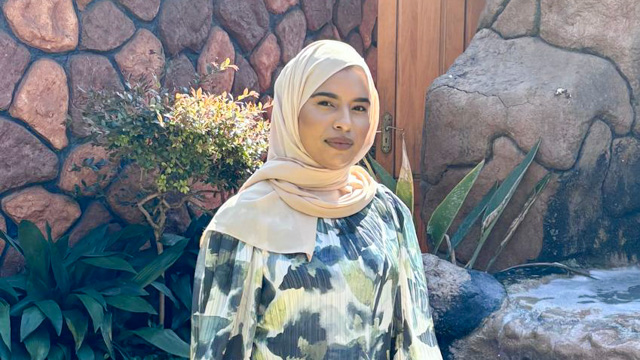
When conservation scientist and philanthropist, Sauleha Rajak walked into the forests of KwaZulu-Natal, she wasn’t just collecting data – she was listening to stories. Some were told in whispers of reverence for ancestral spirits, others in quiet concern over disappearing traditions. “By respecting, learning and immersing myself in the culture,” she reflects, “I came to appreciate the value of co-existence, cultural diversity and building meaningful relationships.”
Now, as a freshly minted PhD graduate in Environmental Science from Rhodes University, Dr Rajak’s research reminds us that the protection of nature and culture cannot, and should not, be separated. Her thesis, An Assessment of the Significance of Sacred Forest Status in Maintaining Forest Condition and Integrity: A Biocultural Perspective, explores how sacred forests – places where spiritual, cultural and ecological worlds meet – can help preserve both biodiversity and identity.
Across the African continent, sacred natural sites have long been safe havens for species and stories alike. Many are protected not by fences or rangers, but by belief systems that honour them as sacred; homes to ancestors, healers and the divine. Yet, as Rajak’s research reveals, these traditions are under pressure.
“Customary rules are still present,” she explains, “but their effectiveness has weakened over time due to shifts in governance and cultural practice.” Economic hardship, migration and the erosion of traditional authority mean that sacred forests, once protected by taboos and ritual, are increasingly vulnerable to unsustainable use.
But her findings also challenge easy assumptions. Using a combination of remote sensing, ecological fieldwork and oral histories, Rajak discovered that some community perceptions of decline didn’t match the data. “In one forest,” she recalls, “the community believed it was less dense because of overharvesting. Yet satellite imagery showed the opposite – the forest had actually expanded over the years.”
This mix of contradiction and insight became the heart of her work: a dialogue between traditional knowledge and scientific evidence, where neither is privileged but both are necessary.
A biocultural approach to conservation
Rajak’s study applied a biocultural approach to conservation – one that recognises the inseparability of people and their environments. “Whilst an ecological lens could document changes in biodiversity,” she says, “it would have overlooked how cultural values, practices and belief systems actively shape and sustain those ecosystems.”
This perspective exposes a blind spot in many mainstream conservation strategies.
Where Western models often focus on measurable ecological outcomes such as species counts, canopy cover, carbon stock, Rajak’s work insists that the cultural and spiritual life of a landscape is equally vital. “Conservation cannot be reduced to ecological metrics alone,” she argues. “It must also recognise diverse worldviews, spiritual values and cultural relationships with nature, for more inclusive and people-centred conservation strategies.”
By highlighting sacred forests as Other Effective Area-Based Conservation Measures, which are spaces outside formal protected areas that still contribute to biodiversity preservation, her research makes a compelling case for plural, community-driven approaches to conservation.
At its core, Rajak’s research asks how ecology, culture and power shape one another and what happens when one falters. “Each relationship enforces the other,” she explains. “Ensuring that they remain mutually enriching contributes to their integrity. The one without the other undermines its meaning and relevance.”
The story of KwaZulu-Natal’s sacred forests is not only ecological but historical and political. Colonialism, missionary influence and apartheid-era governance systematically eroded traditional institutions, weakening the authority that once protected these landscapes. Yet, even amid these disruptions, communities continue to act as custodians of their spiritual landscapes, holding on to fragments of belief that still shape behaviour and belonging.
Rajak’s work suggests that restoring the conservation potential of these forests requires more than environmental policy; it calls for rebuilding cultural confidence and local governance structures, while honouring spiritual relationships with the land.
Knowledge that heals
For Rajak, the PhD journey has been as much personal as professional. Traversing difficult terrain – both literal and emotional – taught her resilience, humility and leadership. “The most personally challenging moment in the field was pushing myself forward in the face of my own anxieties,” she admits. “But these challenges strengthened my self-confidence and capabilities as a leader.”
Her sense of purpose extends beyond academia. As a representative of the South African Youth Biodiversity Network, she has worked to empower young people to take ownership of conservation efforts. “This achievement,” she says, “is a testament to discipline, creativity and perseverance – but most of all, to the belief that knowledge should serve the greater good.”
In a world where climate change, deforestation and cultural loss are often treated as separate crises, Rajak’s research offers a reminder: they are deeply intertwined. Her work, nurtured within Rhodes University’s Department of Environmental Science, underscores the institution’s role as a hub of socially conscious research; the kind that values not just data, but dignity.
Through studies like Rajak’s, Rhodes University continues to demonstrate how knowledge can bridge the gap between science and society, offering a shared vision of sustainability rooted in respect – for both people and the planet.
